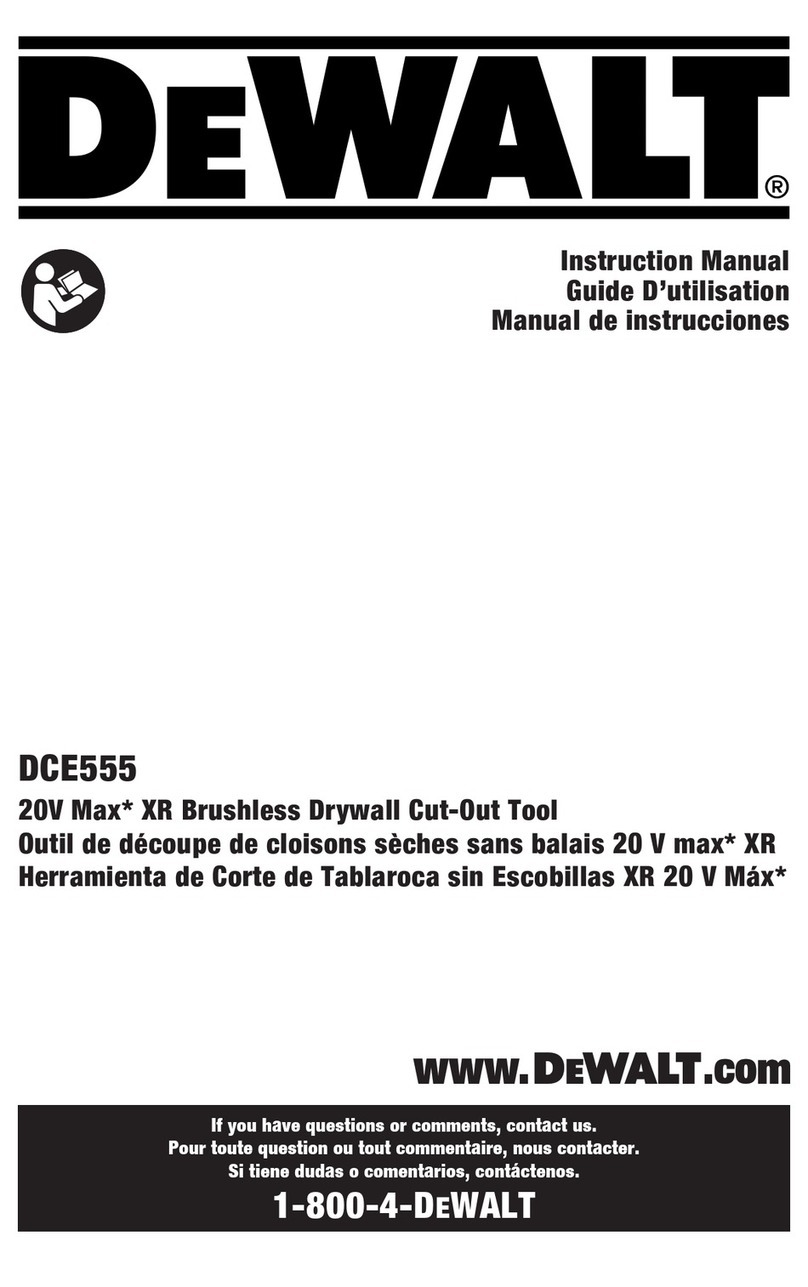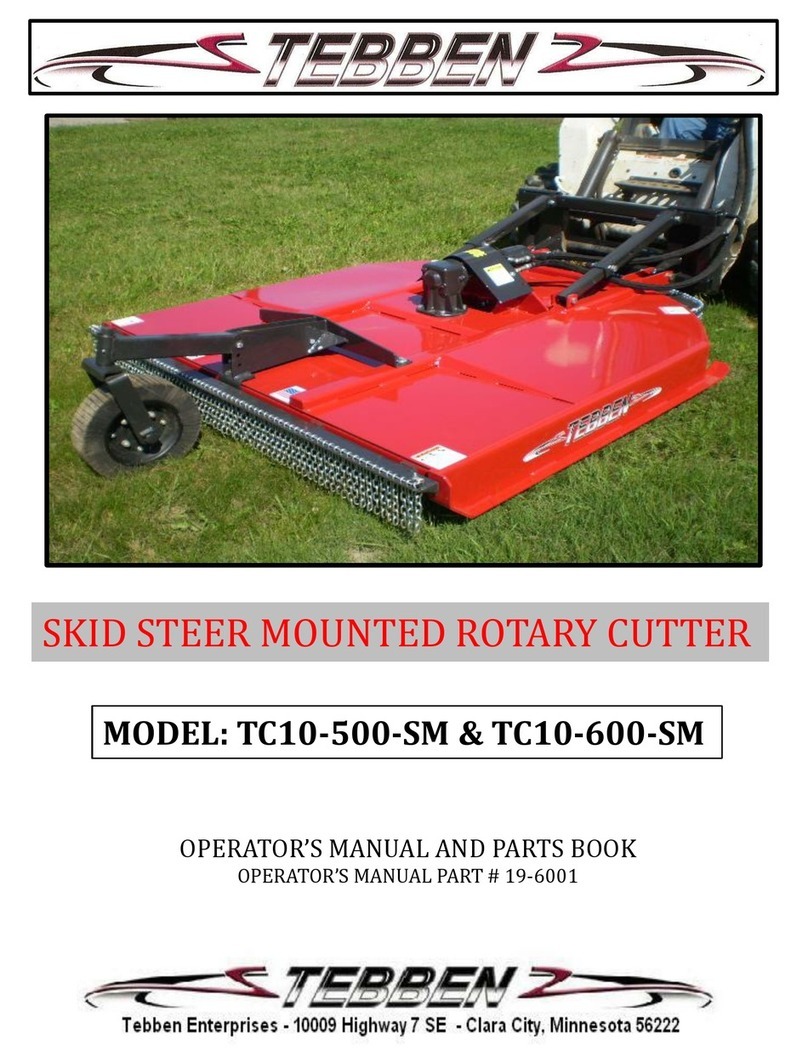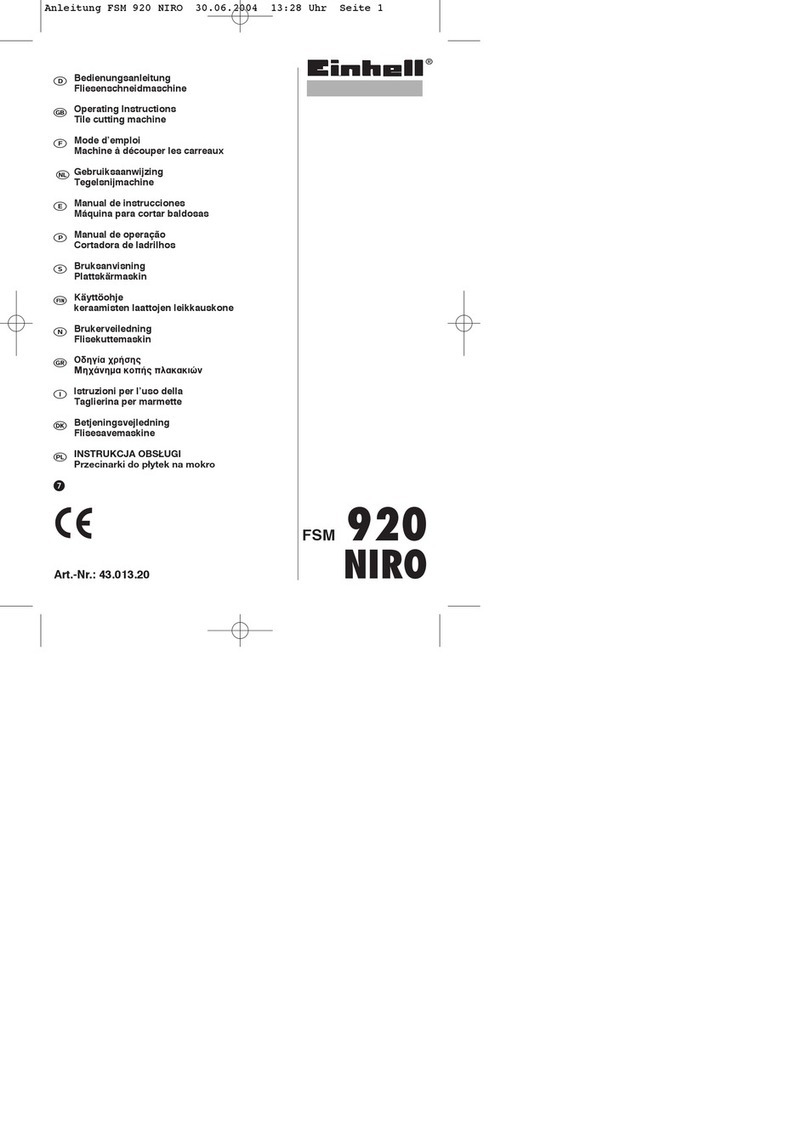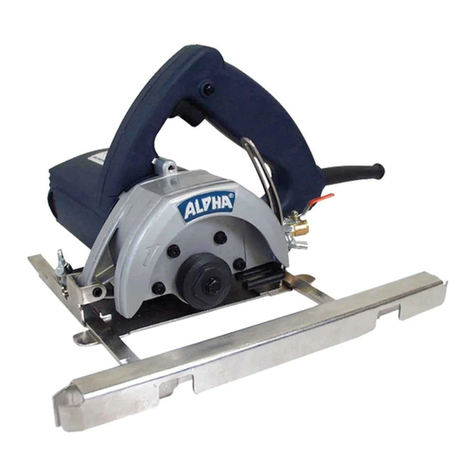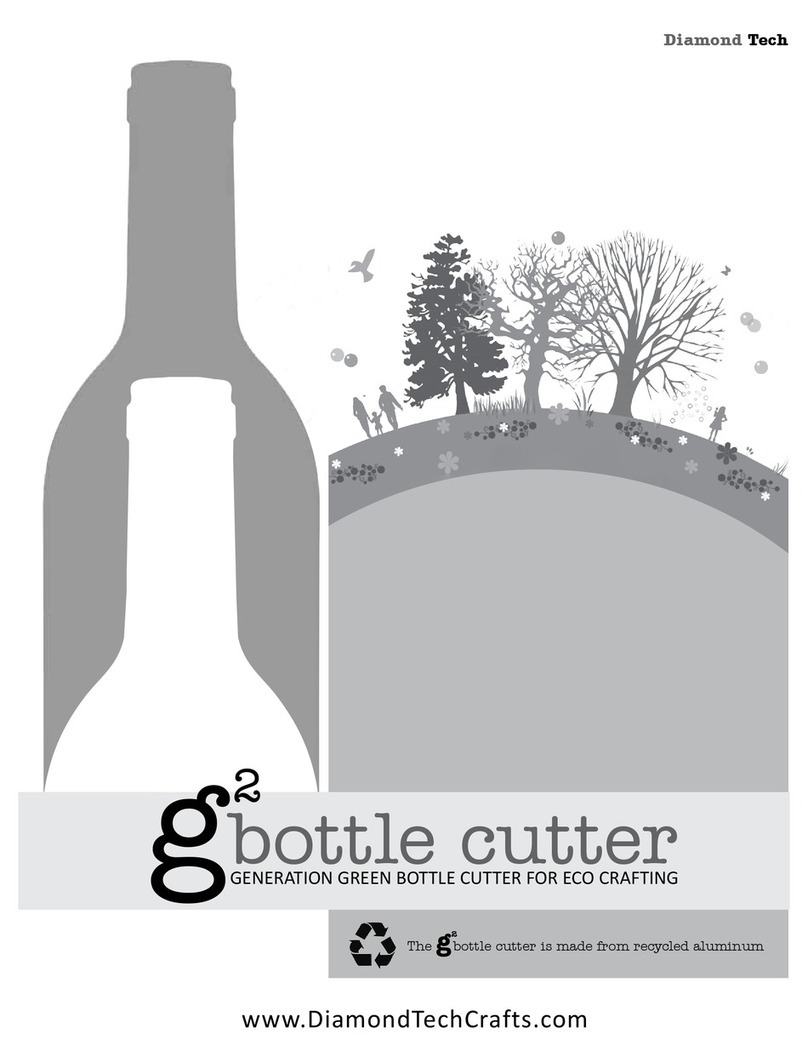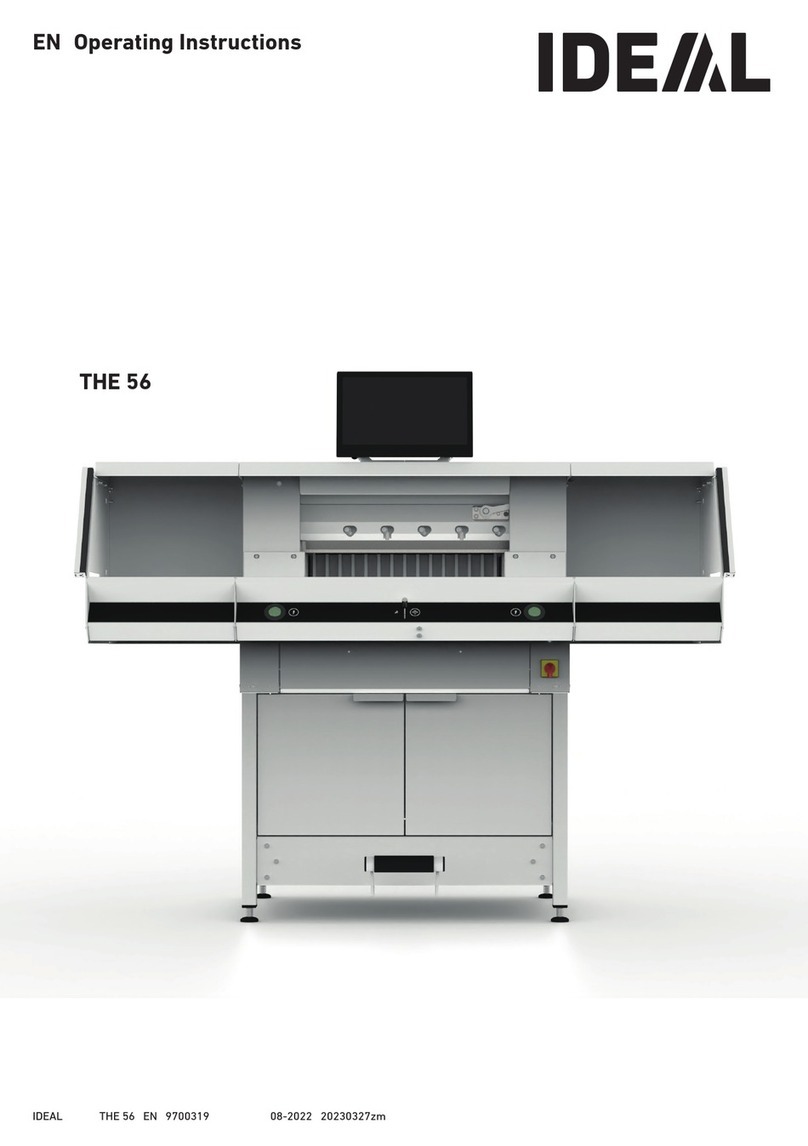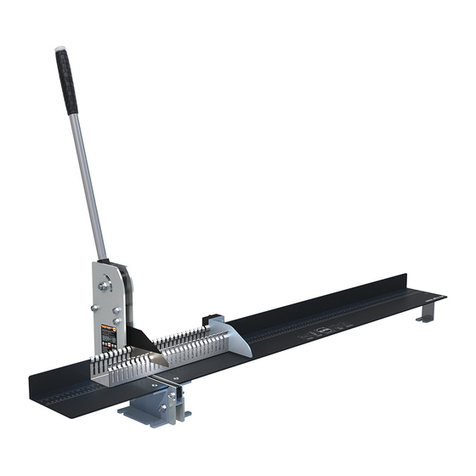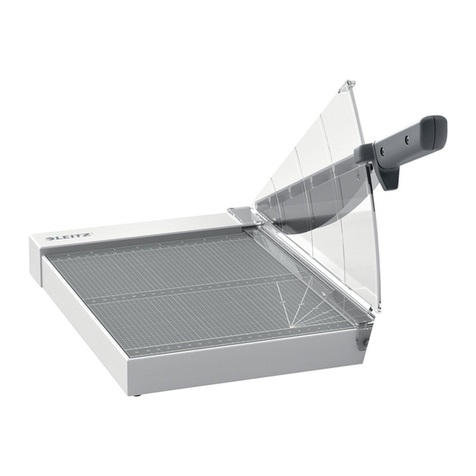TOPMAQ FTD-202A User manual

TILE CUTTING SAW
FTD-202A
Operating/user manual
NOTE: Before you use the machine, carefully read instructions properly. Before attempting to operate the machine
properly, familiarize yourself with the controls and make sure you know how to stop it quickly in an emergency. Save this
user's manual and the other documents supplied with this machine for future reference.
TOPMAQ: 32 Hammersmith Drive, Wigram, Christchurch 8042.
http://www.topmaq.co.nz

- 2 -
CONTENTS PAGE
SPECIFICATIONⅠ----------------------------------------------------------------------------3
OPERATOR’S INSTRUCTIONSⅡ--------------------------------------------------------4
RANGE OF APPLICATIONS AND PROPER USE----------------------------------------------4
GENERAL SAFETY RULES --------------------------------------------------------------------------5
TRANSPORTATION-------------------------------------------------------------------------------------7
ⅢSPECIFIC SAFETY RULES-------------------------------------------------------------7
SPECIAL SAFETY INSTRUCTIONSⅣ--------------------------------------------------9
V INSTALLATION AND OPERATING---------------------------------------------------9
A. STARTING AND STOPPING THE SAW------------------------------------------------------- 9
B. ASSEMBLY-------------------------------------------------------------------------------------------- 9
C. FILLING THE WATER TRAY AND DRAINING-----------------------------------------------11
D. MAKING A PUNCH CUT---------------------------------------------------------------------------11
E. MAKING A STRAIGHT CUT-----------------------------------------------------------------------12
F. MAKING A MITRE CUT-----------------------------------------------------------------------------12
G. MAKING A BEVEL CUT-----------------------------------------------------------------------------12
H. MOVING THE SAW----------------------------------------------------------------------------------12
I. REPLACING THE DIAMOND BLADE-----------------------------------------------------------13
MAINTENANCEⅥ---------------------------------------------------------------------------14
A. PUMP MAINTENANCE--------------------------------------------------------------------------- 14
B. ALIGNMENT MAINTENANCE------------------------------------------------------------------- 15
ⅦTROUBLE SHOOTING------------------------------------------------------------------16
ACCESSORIESⅧ---------------------------------------------------------------------------16
IX SERVICE-------------------------------------------------------------------------------------16

- 3 -
Read operator’s instructions
Dear customer, thanks for your choice of stone cutter FTD-202A. Please read this
manual carefully before installation and operation, and follow it. Please keep this manual
in a safety place for future reference.
ⅠSPECIFICATION
Mains voltage (Volt): 230 VAC/50Hz
Motor capacity S1: 1200W
Insulationclass B
Houseprotectionclass IP54
No load speed (rpm): 2950
Max. Cutting Depth 90°/45°: 35/25mm
Maximum Cutting Length: 762mm
Diamond blade size: Ø200XØ22.23mm(bore)
Table/Extension size: 1100X500mm/0~250mm
Netweight: 53
kgs
Noise emission values determined according to EN 61029 and EN 12418:
The sound pressure level at the work station,
No load: LpA <=71.4dB (A) LpA <=72.3dB (A)
Under
load:
LpA=97.9dB(A) LpA=99.1dB(A)
Uncertainty KpA=1.5 m/s2Uncertainty KpA=1.5 m/s2
The sound power level of the machine,
No load: LwA=84.4dB(A) LwA=85.3dB(A)
Uncertainty KwA=1.5 m/s2Uncertainty KwA=1.5 m/s2
Under load: LwA=110.9dB(A) LwA=112.1dB(A)
Uncertainty KwA=1.5 m/s2Uncertainty KwA=1.5 m/s2
Vibration total values determined according to EN 61029:
No load: Vibration emission value ah=1.20 m/s2Vibration emission value ah=1.20 m/s2
Uncertainty K=0.73 m/s2Uncertainty K=0.76 m/s2
Under load: Vibration emission value ah=1.15 m/s2Vibration emission value ah=1.15 m/s2
Uncertainty K=2.95 m/s2Uncertainty K=3.04 m/s2
Cooling water pump specification:
Power 10W
Qmax 700L/H
Qhead 1.4m
Caution! Any modification which could lead to a change in the original characteristics of the
machine, such as rotational speed or maximum diameter of the cutting-off wheel may be carried
out only by the manufacturer of the machine.

- 4 -
ⅡOPERATOR’S INSTRUCTIONS
RANGE OF APPLICATIONS AND PROPER USE
This cutting saw is developed for the cutting of small and moderate size ceramic, marble, granite, and
masonry sheet. This saw has the possibility to tilt the diamond blade to cut on the bias (45-90 degree).
The diamond blade is cooled by water pump.
Use only the continuous rim diamond blade recommended by the manufacturer.
Warning: Never attempt to cut wood, metal and other similar material with this machine.
Never use this machine in potential explosive environment or underground environment.
KNOW YOUR PRODUCT:
1.Extension table 5. Slide Rail
2. Machine frame 6. Handle
3. Table 7. Rail Stand
4. Diamond blade 8. Stand
1
2
3
4
5
7
6
8

- 5 -
DIRECTION OF BLADE: Please make sure the diamond blade always towards the same
direction as the arrow which is molded on the blade guard.
GENERAL SAFETY RULES
WARNING! When using electric tools basic safety precautions should always be followed to reduce the
risk of fire, electric shock and personal injury including the following.
Read all these instructions before attempting to operate this product and save these instructions.
1 –Keep work area clear
-Cluttered areas and benches invite injuries.
2 – Consider work area environment
-Do not expose tools to rain.
-Do not use tools in damp or wet locations.
-Keep work area well lit.
-Do not use tools in the presence of flammable liquids or gases.
3 – Guard against electric shock
-Avoid body contact with earthed or grounded surfaces (e.g. pipes, radiators, ranges,
refrigerators).
4 – Keep other persons away
-Do not let persons, especially children, not involved in the work touch the tool or the extension
cord and keep them away from the work area.
5 -Store idle tools
-When not in use tools should be stored in a dry locked-up place, out of reach of children.
6 – Do not force the tool
-It will do the job better and safer at the rate for which it was intended.
7 – Use the right tool
-Do not force small tools to do the job of a heavy duty tool.
-Do not use tools for purposes not intended, for example do not use circular saws to cut tree limbs
or legs.
8 –Dress properly
-Do not wear loose clothing or jewelers; they can be caught in moving parts.
-Non-skid footwear is recommended when working operations create dust.
-Wear protective hair covering to contain long hair.
9 -Use protective equipment
-Use safety glasses.
-Use face or dust mask if working operations create dust.
10 –Connect dust extraction equipment
-If the tool is provided for the connection of dust extraction and collecting equipment, ensure these
are connected and properly used.
11 – Do not abuse the cord
-Never yank the cord to disconnect it from the socket. Keep the cord away from heat, oil and
sharp edges.

- 6 -
12 –Secure work
-Where possible use clamps or a vice to hold the work. It is safer than using your hand.
13 –Do not overreach
-Keep proper footing and balance at all times.
14 –Maintain tools with care
-Keep cutting tools sharp and clean for better and safer performance.
-Follow instruction for lubricating and changing accessories.
-Inspect tool cords periodically and if damaged have them repaired by an authorized service
facility.
-Inspect extension cords periodically and replace if damaged.
-Keep handles dry, clean and free from oil and grease.
15 –Disconnect tools
-When not in use, before serving and when changing accessories such as blades, bits and cutters,
disconnect tools from the power supply.
16 –Remove adjusting keys and wrenches
-Form the habit of checking to see that keys and adjusting wrenches are removed from tool before
turning it on.
17 –Avoid unintentional starting
-Ensure switch is in “off” position when plugging in.
18 –Use outdoor extension leads
-When the tool is used outdoors, use only extension cords intended for outdoor use and so
marked.
19 –Stay alert
-Watch what you are doing, use common sense and do not operate the tool when you are tired.
20 –Check damaged parts
-Before further use of tool, it should be carefully checked to determine that it will operate properly
and perform its intended function.
-Check for alignment of moving parts, binding of moving parts, breakage of parts, mounting and
any other conditions that may affect its operation.
-A guard or other part that is damaged should be properly repaired or replaced by an authorized
service center unless otherwise indicated in this instruction manual.
-Have defective switches replaced by an authorized service center.
-Do not use the tool if the switch does not turn it on and off.
21 –Warning
-The use of any accessory or attachment other than one recommended in this instruction manual
may present a risk of personal injury.
22 –Have your tool repaired by a qualified person
-This electric tool complies with the relevant safety rules. Repairs should only be carried out by
qualified persons using original spare parts, otherwise this may result in considerable danger to
the user.
23 - Caution!
- Please follow the instruction of PRCD to avoid affection of the tool by water.
- The inspection of hoses and other critical parts which could deteriorate and the maximum
permitted pressure of the water supply.

- 7 -
- Never use the tool without the PRCD delivered with the tool.
- Replacement of the plug or the supply cord shall always be carried out by the manufacturer of the
tool or his service organization,
- Keep water clear off the electrical parts of the tool and away from persons in the working area.
TRANSPORTATION
●Before transportation, first to lock the cut unit by the lock system.
●This machine is equipped with one set of wheel systems for one person transports it easily from
car to job site and for mobility once on the job site. Please refer to part of Moving the saw.
Note: Before moving the saw, the water should be drained out of the water tray.
ⅢSPECIFIC SAFETY RULES
●Ensure that the directional arrow marked on the diamond blade corresponds with the rotational
direction of the motor.
● With the machine disconnected from the power supply, rotate the diamond blade by hand to ensure
it is free from obstruction.
● Always keep the blade-securing arbor and collars clean.
● Ensure that the blade-securing bolt is securely tightened.
● Never try to cut freehand. Always ensure that the tile to be cut is pressed firmly against the rip
fence.
● Ensure that the work piece that will be cut off has sufficient room to move sideways. Failure to do
so may result in the off-cut binding against the blade.
● Never cut more than one tile at a time.
● Never cut pieces too small to be held securely against the rip fence without leaving enough space
for the hand to be a safe distance from the diamond blade.
● Ensure that the table and surrounding area are clear with the exception of the tile to be cut.
● Before cutting a tile piece, let the diamond blade run freely for a few seconds. If it makes an
unfamiliar sound or vibrates excessively, switch it off immediately and disconnect from the power
supply.
● Let the diamond blade reach full speed before start cut.
● Let the diamond blade come to a complete stop before removing any jammed or off cut material
from around the blade area.
● Never allow the diamond blade to run dry. Failure to keep the water tray topped up will result in
possible over-heating of the diamond.
● Do not expose to rain or moisture.
● Wear suitable protective equipment.
Eye protection ear protection Caution, risk of cutting Hand protection
Shallbeworn shallbeworn shallbeworn
Always ensure that the splitting wedge is correctly set for the work.
Adopt a working position to the left of the diamond blade.

- 8 -
Ensure that cut off tile pieces are not caught by the blade and sent flying.
Never remove loose splinters, Chips pieces while the diamond blade is moving.
Before repairing faults or removing jammed tile, always switch the cutter off and pull out the mains
plug.
If the cutter slot has been knocked out of position, replace the bench liner. Pull out the mains plug
first.
Before switching on, check that all spanners and setting tools have been removed.
When leaving the workplace, switch off the motor and pull out the plug.
After carrying out repair or maintenance work all safety and security fixtures must be replaced
immediately.
The manufacturer’s safety, working and maintenance instructions and the dimensions stated in the
Technical Information must be adhered to.
The relevant regulations for the prevention of accidents and other generally recognized safety
regulations must be followed.
Observe the code of practice drawn up by the trade association .
Operation of the cutter in confined spaces is permissible only if a suitable suction extraction system
is used.
Caution! Switch off cutter immediately and pull out plug if
-the power feed lead and switch are damaged
-the motor is overheating
-smoke is emitted or there is a smell of charred insulating material.
Use only diamond blade for which the maximum possible speed is not less than the maximum
spindle speed of the cutter and the material to be cut;
When transporting the machine, use only transportation devices and do never use guards for
handling or transportation;
Fill the cooling tank 3/4 full of water. It is quite normal for the equipment to cause spluttering during
use.
Pay attention to the width of the work piece. Please refer to Fig.1, if the marked width on “a” is more
than 315 mm, please pull out the extension table to support the work piece.
Fig.1
IV SPECIAL SAFETY INSTRUCTIONS BEFORE USING THE MACHINE
●Check the following points:
1. Does the voltage of the motor correspond to the mains voltage?
a

- 9 -
2. A grounded mains connection (wall socket) needs to be used.
3. Are the mains lead and the mains plug in a good condition without any loose ends or damage.
●Avoid using long extension cables.
●Always place the cutting machine on a flat surface to prevent instability.
●While using the machine
1. Never use-cracked diamond blade, replace them.
2. Be sure that the switch is in the OFF-position before connecting the machine to the mains voltage.
3. Always keep away the mains lead from moving parts of the machine.
4. Do not apply side-pressure to the diamond blade. It can break the blade and cause the danger.
5. Remove the plug out of the wall socket before you open the machine.
Warning: before any operation with this machine, make sure sufficient local lighting has been
provided.
●IMMEDIATELY SWITCH OFF THE MACHINE IN CASE OF:
1. Malfunction of the mains plug, socket or damaged cables.
2. Broken switch.
3. Smoke or smell caused by scorched insulation.
V INSTALLATION AND OPERATING
A.STARTING AND STOPPING THE SAW Insert the plug into a socket with a safety contact. This must
be protected with a fuse e.g. in the terminal box. If an extension cable is required, please note that with
a cable length of up to 20 m cable with a cross-section of 1.5 mm² must be used.
To start the saw, press the green button marked “I”.
To stop the saw, press the red button “O”. (Fig.1)
WARNING: For your own safety, always push the Switch “O” position
when the tool is not in use...in the event of a power failure (all of your
lights go out) or blown fuse or tripped circuit breaker, turn switch “O”
position and remove the key. This will prevent the tool from starting up
again when the power comes back on.
Overload Protection: the motor is equipped with Circuit Breaker.
If the motor is over loaded, gets too hot or the current gets very big,
the circuit breaker will act automatically. If this occurs, please wait a
few minutes until the motor has cooled down and then press
the reset button (beside the On-/Off-Switch) and the cutter can restart.
Note: Residual Circuit Device (RCD) is strongly recommended be installed for your own safety.
B. ASSEMBLY Read the manual carefully before installation
1. Clean the working area, open the package and remove all packing materials, you will find the
folded machine. (Fig.3)
2. Lay the stand on level surface, stand it up according to procedures as shown in Fig.4 to Fig.8.
3. To stabilize stands by adjusting the leveling “set screw” located on the bottom of right front stand.
Fig.2

- 10 -
(Fig.9).
4. Install the handle on cut unit by attached screws. The screws are attached on the mounting place,
Fig.10.
5. The cut unit is locked into place by the lock under the slide rail during transit. Unlock the cut unit
before cutting (Fig.11&12).
NOTE: When not in use, always lock the cut unit to prevent it rolling back and forth along bridge.
Warning: Always lock the cut unit before any maintenance and transportation!
6. For wider tile than the main table designed, the extension table should be pulled out to support the
tile, Fig.13.
7. Install the wheel accessory on to the designed leg, Fig.14A, 14B.
Fig.3 Lay the saw on its side on the
ground
Fig.4-unlock the stand
Fig.5-pull out right stand
Fig.6-Tighten thumb screw to secure
Fig.7- lifts up the frame and
unfold the left stand
Fig.8-stand up the saw
Fig.9-Adjust the set screw on
uneven ground
Fig.10-install the handle
Fig.11 unlock Fig.12 Lock
Fig.13 extension table
Fig.14A-Install wheel accessory
Fig.14B-Install wheel accessory

- 11 -
C. FILLING THE WATER TRAY AND DRAINING
1. Fill the tray with water through the cutting slot. Don't add chemicals or detergents to the water.
2. Be sure that the water is enough so that the diamond blade turns through appropriate water. This is
necessary to cool the blade in a correct way.
3. If the machine is not used, water should be drained. Take out the bigger table piece, loose the jam on
the bottom of the tray, the water will flow out.
4. After cleaning the water tray, put back the table, make sure the pin goes into the pinhole (Fig.15).
D. MAKING A PUNCH CUT
1. Loosen the butterfly knob, the cutting unite will rise (Fig.16).
2. Position the cutting piece against the angle guide and the fence and keep its back upward, and
press the handle for punch cutting. DO NOT force the motor to cut too quickly.
Fig.15-make sure the pin goes into pinhole.
Fig.16-loose butterfly knob for punch cut
Fig.17
Fig.18-Adjust the cutting guide
3. The punch cutting capacity: minimum opening hole size is 75 x75mm for cutting piece with 20mm
thickness, and the over cutting distance is 19mm; maximum opening hole size is 610x610mm for
cutting piece with 35mm thickness, the over cutting distance is 45mm (see Fig.17)
E. MAKING A STRAIGHT CUT
1. Loosen the knob of rip/miter guide and position the rip/miter guide so that it is in straight line, with
the zero aligned with the notch. This indicates “no angle”, or a straight cut. The rip/miter guide will
be at a 90ºangle o the fence. Tighten knob to keep guide in position. (Fig.18).
Fig.19-Making straight
cut
Fig.20-Making angle cut Fig.21A-Loosen the knob
Fig.21B-Making bevel cut
Overcutting
distance

- 12 -
2. Slide the rip miter gauge against the tile and lock the gage by tightening the knob.
3. Position the tile firmly against the fence and rip/miter guide, slowly and smoothly pull blade
assembly handle towards you to begin cutting. DO NOT force the motor to cut too quickly. (Fig.19).
F. MAKING A MITRE CUT
1. Loosen the knob and position the rip/miter guide so that the correct angle you want, 0º to 45º, is
lined up with the notch. Tighten knob at that position.
2. Align the tile with rip/miter guide and hold firmly against guide. Turn on laser switch. Note that
laser will show cutting line. As in above straight cut, slowly and smoothly pull blade assembly handle
towards you to begin cutting. (Fig.20)
G. MAKING A BEVEL CUT
1. Loosen the knobs located on each rail stand of stoner cutter (Fig.21).
2. Tilt the bridge to the desired bevel angle 0º to 45º. Be sure to line up the bevel angle degree
markings on each of rail stand, it will be easier to detect the degree through transparent window.
3. Tighten the knobs and follow directions above to make cut.
H. MOVING THE SAW
1. Lift the machine and drag the wheels to make them stand against ground (Fig.22A, 22B, 22C,22D).
2. Then raise the opposite end by handle to move the saw forward,Fig.22E,22F)
Note: While the machine is in use, make sure the wheels are hanged up to locked position Fig.
18.8.
WARNING: Before moving the saw, drain the water tray and lock the cut unit.
Fig.22A Fig.22B Fig.22C
Fig.22D
Fig.22E-Move the saw for short distance on worksite.
Fig.22F-Move the saw for long distance

- 13 -
I. REPLACING THE DIAMOND BLADE
WARNING! Disconnect the power supply before installing or making adjustments
to the diamond blade.
●CHOICE OF THE DIAMOND BLADE Only use diamond blade with diameter of 200mm, the bore
of the blade must be 22.23mm.
●REPLACING THE DIAMOND BLADE
1. First, loose the knob to open the blade guard.
Fig.23
Fig.24
2. Ensure that the shaft and flanges are clean and re-fit the blade in the opposite manner.
Directional arrows on blade MUST line up with directional arrow on blade guard, so that material
to be cut is against the direction of rotation.
3. Replace the flange back, and adjust the blade to get the best balance of Blade.
4. Fix the lock nut tightly.
5. Close the blade guard and secure the knob.
VI MAINTENANCE
CAUTION! While maintaining and cleaning the machine pull the plug from the mains socket. Never use
water or other aggressive liquids while cleaning electrical parts of the machine.
●Periodic maintenance of the saw will prevent unnecessary problems. Keep the ventilation slots of
the stone cutter clean to prevent overheating of the motor.
●Dry the saw as much as possible after using.
A. PUMP MAINTENANCE
Fig.25A
Fig.25B-Remove the
connection box cover
Fig.25C-Loose and pull
out the terminal

- 14 -
Fig.25D-Loose and replace the pump.
Warning: make sure that you have pulled the Plug from the main socket when you do the
following maintenance.
1. Clean the pump To clean the pump, remove the intake cover, and then take out of the filter foam
and impeller cover. Use a small brush or stream of water to remove any debris on the foam and the
impeller. (Fig.25A)
Note: Please clean the pump immediately after you stop use.Otherwise the dry debris could
stick the filter foam and the impeller, which will cause you to replace the filter foam or the
pump.
2. Replace the filter foam To replace the filter foam, remove the intake cover, then take out of the
filter foam and put into a new one.
3. Replace the pump After replacing new filter foam, if the pump still does not work, you have to
replace problem pump with a new one, only use the pump recommended by the manufacturer of
the machine. The changing procedures are as follows:
3.1 Loosen the bolt of the pump connecting box located inside the main frame and remove the cover
(Fig.25B).
3.2 Loosen the bolt of the pump cable lock and take the pump plug out of connecting box (Fig.25C,
25D).
3.3 Take out the pump and replace a new one, install the new pump by reversing above procedures
Note: Only an authorized person should perform other repairs!
B. ALIGNMENT MAINTENANCE
This saw motor or bridge does not need to be squared up or aligned, since the bridge does not allow
the saw motor to move. When it appears that the saw is out of alignment, it is the rip fence that needs to
be squared up.
Tools needed: 24” Framing Square, Phillips Screw Driver and 1/4″Nut Driver or Pliers
The following steps should be used to align the rip fence for the Bridge Saw:
1. Pull the power unit towards you and lock in place with the transport lever.
2. Once the power unit is secured, place the Framing square firmly against the blade on the
left side of the cutting surface. The square must be flush with the blade. (See Fig.26A).
3. Slide the square into the rip fence, making sure the square stays firmly against the blade. Look for
a gap between the square and the rip fence. If there is a gap, adjustments will be necessary. (See
Fig.26B)
4. To adjust the gap, first remove the Angle cutting guide. This will expose two screws in the
aluminum track. Loosen both screws in the extruded aluminum bar. (See Fig.26C&D)
5. From underneath the saw, directly below the rip fence, there are two 1/4″bolts located under the
left rip fence and 2 bolts under the right rip fence. Loosen both bolts for the rip fence that you are
adjusting. (See Fig.26E&F)
6. Once the screws are loose, easily slide the rip fence above, allowing you to close the

- 15 -
gap between the square and the rip fence. When the square is flush against the rip fence re-tighten the
two 1/4″bolts from the side you are adjusting. If necessary, repeat the same steps for the other side.
(See Fig.26G)
7. Once both rip fences are secured in place slide the extruded aluminum angle bar firmly against
both rip fences and tighten in place for additional support.
Fig.26A Fig.26B Fig.26C
Fig.26D Fig.26E
Fig.26F
Fig.26G
VII TROUBLE SHOOTING
Below we have listed a number of possible causes and corresponding solutions in case the machine
dose not function as it should:
●The motor gets hot.
1. The ventilation slots in the motor are blocked with dirt:
-Clean the cool ventilation slots;
2. The motor is defective:
-Have your stone cutter repaired by your supplier.
●The connected machine does not work.
1. Interruption in the mains connection;
-Check mains connection for fracture.

- 16 -
2. The switch is broken.
-Have your stone cutter repaired by your supplier.
VIII ACCESSORIES
1. Rip/miter cutting guide.
2. Hexagonal blade wrench.
3. Motor shaft holding wrench.
4. Handle.
IX SERVICE AND ADDRESS:
TOPMAQ: 32 Hammersmith Drive, Wigram, Christchurch 8042.
http://www.topmaq.co.nz
Table of contents

